
Sanofi’s Ostelin Goes Unconventional to Portray Women’s Strength in All Its Glory

What does it mean to be strong? To a woman, how does that take on a much deeper layer of meaning? It’s not physical strength or capability. Instead, Sanofi cuts through convention with its Ostelin brand proposition to connect with women at the core – by celebrating the resilience of women in their many roles and in the situations they encounter in life.
Ostelin has been long regarded as the #1 brand in bone health and vitamin D in Australia, well known to its core audience of women in their 50s. Following a commissioned research this year that identified women’s need for a solution that covers multiple health needs, Sanofi wanted to embark on a campaign that reached out to women in their 30s. The goal was to address the broader need for women’s health.
Led by Publicis Worldwide, the Ostelin Strong campaign set out to capture the emotional connection with women. “Ostelin set itself the challenge to become the expression of women’s empowerment. The bone strength credentials it has built over the past 10 years, and the trust and relationship with women means a broader view of strength can be easily forged,” says Simone Waugh, managing director of Publicis Worldwide.
Adds Simon Murphy, chief strategy officer, “Brands with Purpose move people, and Ostelin has shown it can move trade and market-share too. It’s given Sanofi and the agencies a sense of belief and pride in the work.”
And so it was that a riveting campaign was created – depicting women of all ages, races and physical appearances in raw moments of happiness, sadness, tragedy, triumph, failure and victory.
LBB> The Ostelin Strong campaign featured women who are handicapped and have had mastectomies. How did the unconventional idea for portraying women’s strength come about?
Simon> It is an innate trait of many women to find their strength in life’s most challenging moments and they shine in these moments. We wanted to celebrate women’s strength in all of its complexity and beauty, and acknowledge that inner strength is the true beauty of a woman.
Simone> It’s not about your physical appearance. You realise when you’ve had breast cancer the most important thing is what’s inside you, not what your mastectomy looks like. As a woman with physical disability, it’s about how you deal with it and your inner strength to find what you can do, versus what you can’t do.
LBB> How did the creative team brainstorm and develop the campaign idea? Talk us through the process.
Simone> Our ambition was always to capture and push the contemporary conversation around women and strength. We understood that real strength is not what’s on the outside, but what’s within, but we didn’t quite know what that meant or looked like for women in 2022.
We spoke to a lot of women about strength and the pervading insight was that women know they’re strong. The Doves and Bodyforms gave them the confidence ‘in their skin’, but in 2022, the job was largely done, thanks to them. They don’t need brands being their cheerleader on the sidelines.
So, the conversation has shifted from instilling in women a sense of belief in themselves to one where we finally recognise and acknowledge the strength they know is inside. The role for Ostelin then becomes one of enablement, and not patronisation.
Simon> We then crafted each vignette into a fine balance that is true to women and Ostelin, in hopefully an insightful or observed way. It was about finding a balance in expressions that were true to physical, emotional and mental strength all at the same time.
LBB> Publicis partnered with Getty to find the right interpretations of female strength in their photos. Why Getty and how was the shortlist done?
Simon> We partnered with Getty Images, via the Photography Custom Creation platform, thanks to Nina Barone and Tara Dilloughery. Here, Getty briefed their network based on our briefs, from which we received back over 6,000 images to select from. Working with Getty allowed us the unique opportunity to tap into their worldwide audience of creators, to truly get a broad interpretation of strength. Our creative team then sifted through the 6,000 images and selected the 375 which we now have exclusive use of and use throughout the campaign.

LBB> What were the highlights of producing this campaign and why were they important?
Simon> Receiving the over 6,000 images and having to dwindle them down was definitely a production highlight. The unfiltered snapshots of woman were amazing; we were overwhelmed by the enthusiasm on the brief. Another highlight for the team was working with our composer to develop a unique sound to help elevate the images. The craft in the development of this music may not stand as the hero of the campaign, but for us, it is the glue that pulls everything together.
LBB> What challenges or issues did you encounter on the journey?
Simone> We learnt from the campaign development and research that strength is truly interpreted differently by everyone, and we wanted to make sure that women of all ages were able to see a strength they can relate to or understand.
Simon> Some of the images were confronting and challenged some people at Sanofi as they felt uncomfortable, but that was perfect as it opened up the conversation about how powerful this campaign could be. Also, the approach we took with Getty meant the team had to relinquish a level of control as we threw open the doors to the Getty content creators to interpret our brief in their own way, but the results speak for themselves!
LBB> In terms of campaign strategy, the executions include TVC, online videos, social media, a website and point of sale in pharmacies and groceries. Do elaborate on how each strategy took shape and the metrics/impressions achieved as a result.
Simon> For such a powerful idea, we needed a comprehensive campaign story for Ostelin that built purpose, and sold product. To position Ostelin as the contemporary champion of women’s strength, we partnered 100 female influencers. Then, we worked on building an understanding of the need to invest in bone strength with first-party data via the D-test. Thirdly, we reaffirmed why Ostelin is the preferred choice for women’s strength by encouraging consumers to look after their bone strength with the different Ostelin ranges.
LBB> What kinds of social media comments and consumer feedback were received?
Simon> We’ve seen a lot of positive feedback from the Ostelin community. They’ve called it beautiful and powerful. And the women featured in the photographs have expressed their excitement about being part of the story. Ostelin has also started working with influencers for this campaign, and this has introduced the brand to new audiences where we are seeing that women want to talk about their strength and celebrate that strength with other women.
LBB> The campaign also includes a partnership with a female-run charity called 100 Women. Do elaborate on the significance of this partnership. How did it align with the PR strategy?
Simon> As Australia’s leading bone health brand, we wanted to play a role in helping empower Australian women further. 100 Women was the ideal charity to work with as they provide grants to diverse organisations to advance the safety, health, education and economic freedom of women and girls globally. Their collective giving approach gives everyday people the chance to make a positive difference to the lives of others. Our PR strategy and 100 Women partnership involved 25 ambassadors and we also conducted a bespoke piece of research on women’s strength, launched, with a panel of strong women and started a partnership with MamaMia.
LBB> What is the tangible impact of the campaign on the community and has it led to social change?
Simon> It’s early days and so the social change we’re looking for is a longer-term objective.
We’re looking forward to celebrating the 100 Women Grant Winners (announced in October 2022) and we will then learn more about the impact the grant and Project Strong will have for women across the world.
Simone> The pandemic has served as a moment of reckoning for people to really value and take control of their health in a way we might not have before. Less reactive. More proactive. Less medicinal. More self-care. Every indication suggests this will be a long-term behaviour change.
On one hand, consumers are more knowledgeable and sophisticated about what real health looks like. On the other, it’s harder to have confidence in the health choices we make.
What is sure is that consumers see their health as an interconnected ecosystem. The old model of one ingredient, one silver-bullet benefit will come under threat in favour of brands that help consumers manage their own ecosystem of health. The connection between physical and mental health will be better understood. In some markets, physical wellness will lead to mental wellness, in other markets vice versa.
Ultimately, the nutrition supplements industry needs to evolve into the wellness industry, untether themselves from the limitations of formats that fit well on-shelf and be a leader for consumers who are actively managing their health in new, and varied ways – or be left on the shelf.













